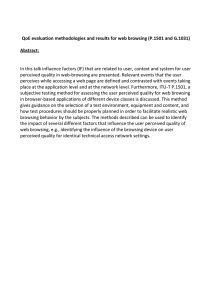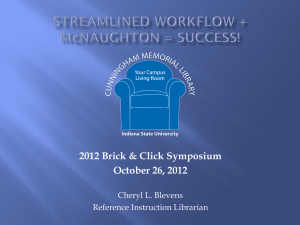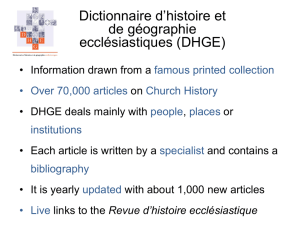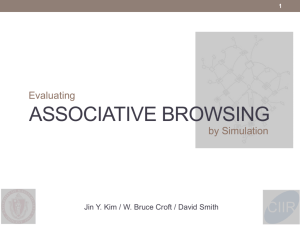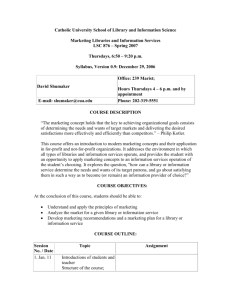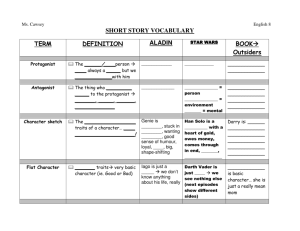Locating Books/ Browsing Stacks
advertisement
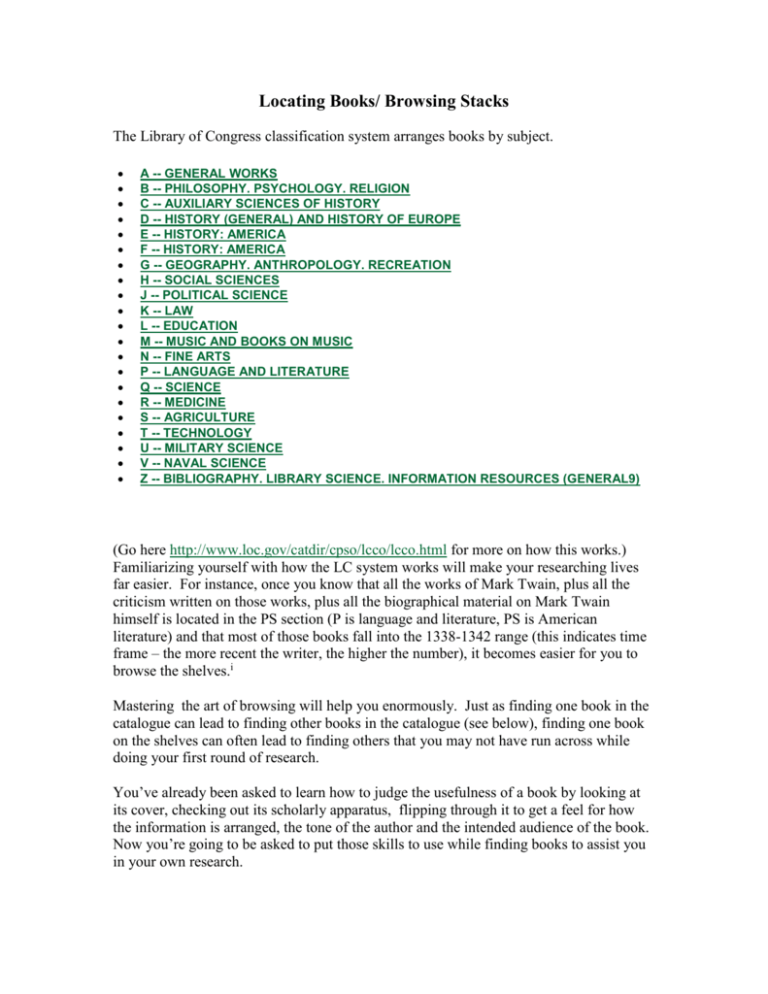
Locating Books/ Browsing Stacks The Library of Congress classification system arranges books by subject. A -- GENERAL WORKS B -- PHILOSOPHY. PSYCHOLOGY. RELIGION C -- AUXILIARY SCIENCES OF HISTORY D -- HISTORY (GENERAL) AND HISTORY OF EUROPE E -- HISTORY: AMERICA F -- HISTORY: AMERICA G -- GEOGRAPHY. ANTHROPOLOGY. RECREATION H -- SOCIAL SCIENCES J -- POLITICAL SCIENCE K -- LAW L -- EDUCATION M -- MUSIC AND BOOKS ON MUSIC N -- FINE ARTS P -- LANGUAGE AND LITERATURE Q -- SCIENCE R -- MEDICINE S -- AGRICULTURE T -- TECHNOLOGY U -- MILITARY SCIENCE V -- NAVAL SCIENCE Z -- BIBLIOGRAPHY. LIBRARY SCIENCE. INFORMATION RESOURCES (GENERAL9) (Go here http://www.loc.gov/catdir/cpso/lcco/lcco.html for more on how this works.) Familiarizing yourself with how the LC system works will make your researching lives far easier. For instance, once you know that all the works of Mark Twain, plus all the criticism written on those works, plus all the biographical material on Mark Twain himself is located in the PS section (P is language and literature, PS is American literature) and that most of those books fall into the 1338-1342 range (this indicates time frame – the more recent the writer, the higher the number), it becomes easier for you to browse the shelves.i Mastering the art of browsing will help you enormously. Just as finding one book in the catalogue can lead to finding other books in the catalogue (see below), finding one book on the shelves can often lead to finding others that you may not have run across while doing your first round of research. You’ve already been asked to learn how to judge the usefulness of a book by looking at its cover, checking out its scholarly apparatus, flipping through it to get a feel for how the information is arranged, the tone of the author and the intended audience of the book. Now you’re going to be asked to put those skills to use while finding books to assist you in your own research. Procedure 1. Using ALADIN, find a book on your research topic. Note the search terms you use. You may have to use several different combinations before you come up with something that looks useful. Note all search terms used. 2. Your initial decision on whether or not a book may be of use to you may be based solely on title. This can no doubt be helpful in weeding out hits that are clearly not going to be of any use to you, but it may also steer you away from helpful sources. This is potentially where browsing comes in. 3. Find a title that looks promising. Click on the title to go to the Detailed Record. Here you will find much of the information you would find by flipping though the physical book. In many cases the Detailed Record will include the table of contents, and indicate whether or not the book has a bibliography, and an index. It will also list additional subject terms that you can also use to search with. 4. Choose one of these subject terms (one that you have not already tried, obviously) and search ALADIN again, using that term. Note your terms here as well. 5. Find a second book, going through the same process of elimination, educated guessing and assessment of the source using the Detailed Records. 6. Note LC numbers for the two books you’ve found, but also note the LC listings for other books that you thought might also be of some interest. Are they clustered together? In other words, does it look like most of the books you’re looking for are in one section or do they span several different areas? Ask yourself what this tells you about your topic. 7. Now that you have the LC numbers for two books, go get them. 8. While you are there, browse the books nearby. Are there other books there that look like they might be useful to you as well? Find one additional book for your research in this manner. 9. You now have three books that will potentially be of use to you as you go forward with your research. Note all three titles. Turn in search terms and book titles (indicating the book – or books – you found by searching ALADIN as opposed to browsing the selves). Note – thinking in terms of the Library of Congress classifications may also help you make a decision on the nature of your own paper. Are you pulling all of your sources from the Social Sciences section? Language and Literature? Philosophy? i Using Resources So you have a pile of books – physical or electronic. What do you do with them? What you don’t *have* to do is read them cover to cover. Often there may be just one or two chapters that are particularly relevant to your topic, and that’s all you have to read. Often, one good book will lead to another. Whether you are using physical books or you are accessing books online, there are ways to make the most of the resources you have. The first and most useful is to look at the Bibliography of the books you have already found. What sources did the author make use of? Scan titles to see if any of those sources might potentially be of use to you. Look also at the endnotes (or footnotes) of chapters in the book that are most relevant to your topic. See if there are references to other sources there as well. Understanding the larger scholarly conversation happening around a given topic will help you construct your own argument and will also lend that argument authority.
